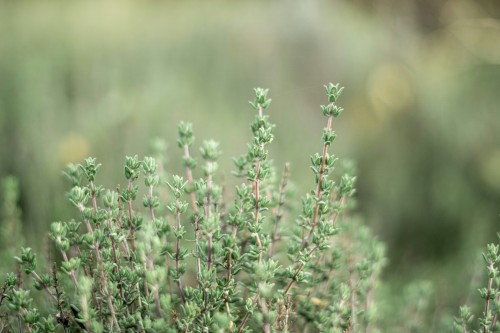Thyme
A Complete Guide to growing Thyme in the UK
Introduction
Thyme is a fragrant, low-growing, hardy perennial herb prized for cooking, pollinator-friendly flowers and groundcover use. It's rewarding to grow because it requires little maintenance once established, tolerates drought and poor soils, and is versatile in beds, borders and containers. You can grow thyme from seed, from cuttings or by buying established plants; each method has advantages (cost vs speed).
Types and Timing
Common thyme (Thymus vulgaris) is the standard culinary variety. Other options include:
Lemon thyme (T. x citriodorus) — mild citrus note for fish or salads.
Creeping thyme (e.g. T. serpyllum) — excellent as a lawn alternative or between stepping stones.
Variegated thymes — ornamental and useful in mixed containers.
Timing:
Seeds: Sow indoors early spring (Feb–Apr) for an early start, or sow outdoors in late spring once soil warms.
Cuttings / divisions: Best taken in late spring–early summer when new growth is active.
Planting out: After last frosts (usually May) unless using hardy varieties and cloches; container plants can be planted anytime in mild weather.
Succession: Sow or take cuttings in successive weeks to stagger new plants for containers or replacements.
Overwintering: Thyme is generally hardy in the UK, but young plants and container specimens benefit from light protection in severe winters.
Site and Soil Requirements
Sun: Full sun gives compact, aromatic growth and abundant flowers. In hotter, dry locations partial afternoon shade can help.
Drainage and soil: Thyme prefers light, free-draining soil (sandy or gritty loam). It dislikes waterlogged soils — poor drainage is the most common cause of failure.
Soil prep: Improve heavy soils with sharp sand or grit and organic matter to lift structure and drainage. Aim for neutral to slightly alkaline pH; thyme tolerates low fertility and performs poorly in overly rich soils which encourage soft, floppy growth.
Containers: Use a free-draining compost mix (multi-purpose compost with added grit or perlite). Choose shallow wide pots for spreading types and ensure good drainage holes.
Propagation & Planting
From seed:
Sow thinly on the surface or cover very lightly (seeds need light). A shallow sowing depth (0–2 mm) is best.
Germination: 10–21 days in warm conditions (15–20°C). Keep compost just moist — not wet.
Prick out when seedlings develop true leaves into modular trays or small pots; give 1–2 leaves between plants before transplanting.
From cuttings/divisions:
Take non-flowering softwood cuttings (about 4–6 cm) in late spring/early summer. Remove lower leaves and insert into gritty compost; roots form in 2–4 weeks.
Divisions: In spring or autumn, lift a mature clump and divide into sections, replanting with care to reduce transplant shock.
Planting out:
Spacing: 20–30 cm between plants for upright culinary thyme; creeping thymes can be planted closer (10–15 cm) to form a mat.
Planting depth: Plant at the same depth as in the pot. Firm soil around roots and water in lightly.
Hardening off: If moving from indoor to outdoor, harden off over 7–14 days, increasing outdoor exposure daily.
Growing & Maintenance
Watering: Water regularly while establishing. Once mature, thyme tolerates dry conditions and needs infrequent watering — overwatering can cause root rot.
Feeding: Thyme is a light feeder. A single application of a balanced, low-strength fertiliser in spring is usually enough. Avoid high-nitrogen feeds.
Pruning: Regular clipping encourages bushy growth. Trim back after flowering (late summer) to prevent woody, leggy stems. Avoid cutting into old wood — cut back to green growth.
Weeding & mulch: Keep the area around thyme weed-free. A light, coarse mulch of gravel or grit helps drainage; avoid rich organic mulches directly on crowns.
Protection & staking: Thyme doesn’t need staking. In exposed sites, protect young plants from strong winds. In severe winters, a dry mulch around the crown or moving pots to a sheltered spot helps.
Harvest and Post-Harvest
Harvest timing: You can harvest leaves any time once plants are well-established. For best flavour, harvest just before or as flowers start to open. Frequent light harvesting encourages fresh growth.
How to harvest: Snip stems with scissors or pinch leaves. Avoid removing more than one-third of the plant at once.
Drying & storage: Tie stems in small bunches and hang in a warm, airy place out of direct sun to dry. Remove leaves from stems and store in airtight jars. Fresh leaves keep a few days in the fridge; frozen chopped thyme stored in ice-cube trays is handy for cooking.
Troubleshooting & Pests
Common problems:
Waterlogged soil / root rot — ensure drainage, lift and replant into a drier site or amend soil with grit.
Leggy, sparse growth — often caused by lack of sunlight or overly rich soil; move to a sunnier spot and avoid heavy feeding.
Powdery mildew — usually in humid conditions; improve air circulation and avoid overhead watering. Remove affected growth.
Pests — aphids and spider mites can occasionally occur; blast with water, encourage predators, or use an insecticidal soap if needed.
Winter dieback — protect young or container plants in severe cold, reduce watering in winter and avoid soggy soil.
Tips from Growers / FAQs
Grow thyme in full sun for the best aroma — less sun gives weaker flavour.
If plants become woody, take new softwood cuttings to renew stock rather than trying to rejuvenate old wood.
Use creeping thyme between paving stones — it smells great when trodden and tolerates light foot traffic.
In the UK, thyme will usually survive outdoors year-round; in containers, bring plants close to a wall or indoors during extreme frost.
Trim lightly after the first flowering to promote a tidy second flush of foliage.
Resources & References
General herb-growing advice and community forums
© What to plant 2025. All rights reserved
